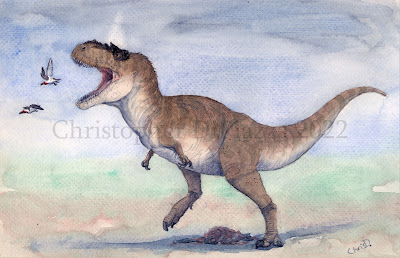Albertosaurus sarcophagus was a large meat-eating dinosaur, that lived in what is now Alberta, Canada, and possibly parts of the USA, including Montana, Wyoming, and New Mexico, during the late Cretaceous period between 71 and 68 million years ago. From snout to tail the largest adults would have measured 30 feet (about 9 meters) long. The genus name translates to "Alberta Reptile" in reference to Alberta, the province in Canada where its bones have been found. The species name is derived from the Greek term, sarkophagos, which translates to "flesh eater".
 |
| Albertosaurus sarcophagus life reconstruction in watercolor by Christopher DiPiazza. |
Albertosaurus was a member of the tyrannosaurid family of theropod dinosaurs. Like other members of this group, it possessed a proportionally large skull with forward-facing eye sockets, large curved, serrated teeth on the sides of its jaws and narrow teeth in the front of its mouth with a D-shaped cross section, horn-like crests over the eyes and snout, proportionally long legs, and proportionally short arms with two fingers on each hand. Tyrannosaurus is by far the most famous member of this group, but Albertosaurus was the most closely related to Gorgosaurus. In fact Albertosaurus and Gorgosaurus are almost indistinguishable in many ways to the point where a few have proposed they should belong in the same genus.
We actually know a lot about Albertosaurus compared to most fossil dinosaurs due to the unusually high number of individuals that have been found. Even more impressive, the majority of these Albertosaurus specimens are actually all from the same site, called the Dry Island Bone Bed, in Alberta, Canada, which includes at least 12 (but potentially over 20) individual animals. This group comprises of Albertosaurus skeletons of varying sizes/ages that all appeared to have died at roughly the same time. Many paleontologists think this discovery also suggests that Albertosaurus may have been social, perhaps even pack hunters, when alive. Others say they could have simply been congregating around a river or lake bed during a drought and died of thirst together.
Because so many Albertosaurus of different sizes have been discovered, paleontologists were able to compare the different sizes and ages of the various specimens and map out how Albertosaurus grew. Like other known tyrannosaurids we have juvenile specimens from, we know Albertosaurus was extremely lightly built, with proportionally long legs when it was younger. It would get bulkier and more robust as an adult. We also know most tyrannosaurids grew very rapidly in the beginning of their lives, reaching close to adult size at around 15 years old. From there, they would continue to grow but at a much slower pace. This observation has led many paleontologists to propose that tyrannosaurids filled multiple different predator roles in their ecosystems as they aged, specializing in hunting smaller faster prey, like smaller fast-running theropods and ornithopods, when younger, then graduating to hunting larger bulkier prey, like hadrosaurs, ceratopsians, and ankylosaurs, when they were more mature.
 |
| Albertosaurus skull cast on display at the Copenhagen Geological Museum. |
Recently fossils from what appear to be a hatchling Albertosaurus were unearthed. A tiny toe bone and tooth thought to be from a tyrannosaurid from the same area Albertosaurus fossils are known from were presented to the public in 2021. Despite only being two parts, they possessed features that paleontologists were able to deduct as only being from a tyrannosaurid. Previous to this discovery, baby tyrannosaurs this small were a total mystery. It is still a mystery why they are so rare, but these few baby bones could certainly help us understand them better!
When alive, Albertosaurus would have been a top predator in its community. It would have coexisted with (and probably ate) other dinosaurs, like Hypacrosaurus, Pachyrhinosaurus canadensis, Sphaerotholus, Anodontosaurus, and Atrociraptor.
References
Eberth, David A.; Currie, Philip J. (2010). "Stratigraphy, sedimentology, and taphonomy of the Albertosaurus bonebed (upper Horseshoe Canyon Formation; Maastrichtian), southern Alberta, Canada". Canadian Journal of Earth Sciences. 47 (9): 1119–1143.
Erickson, Gregory M.; Makovicky, Peter J.; Currie, Philip J.; Norell, Mark A.; Yerby, Scott A.; Brochu, Christopher A. (2004). "Gigantism and comparative life-history parameters of tyrannosaurid dinosaurs" (PDF). Nature. 430 (7001): 772–775.
Funston, Gregory S (2021) "Baby tyrannosaurid bones and teeth from the Late Cretaceous of western North America" Canadian Journal of Earth Sciences. 454
Holtz, Thomas R. (2004). "Tyrannosauroidea". In Weishampel,
